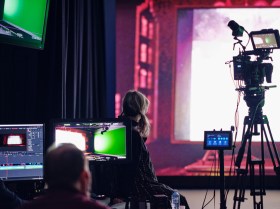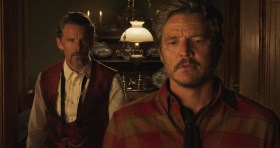Art doesn’t exist in a vacuum. It’s also a business, and as The Whiteley Art Scandal reveals in almost forensic detail, it can be a very shonky business indeed. The big strength of this extremely watchable two-part series isn’t that it’s a gripping true crime story (though it is that). It’s that it’s a look at what goes on behind the big glossy paintings on the walls of the rich and well-connected. The merits of the paintings themselves are secondary at best; once you start talking seven-figure sums, everything else fades into the background.
The first episode’s opening preamble lays out the story: Brett Whiteley’s works are selling for millions, and now that he’s dead he’s not around to say ‘I didn’t paint that’. Often fraud cases are tricky to prove. In the case of three particular paintings, doubts had been flying around for a while, in large part because they’d passed through the hands of Peter Gant, a Melbourne-based dealer who’d had previous problems with the law.
Then photos turned up of what looked like the paintings being worked on in a Melbourne warehouse in 2007 – which was a problem, as Whiteley died in 1991. Now it was the biggest case of art fraud in Australia, with $4.5 million worth of possibly fake art in the spotlight. The photos seemed to make it an open-and-shut case; the way it played out in court was a little more complicated.
Painting a picture
The first episode largely leads up to the court case, tracing the path the paintings took to get there. The second goes through the evidence, some of which came across as convincing to the jury, other parts less so. Art experts, witnesses and technical examinations of the paintings all came up; how the case was managed, and how the jury arrived at their verdict, would come under a very harsh spotlight.
The art dealers through whose hands the disputed paintings passed almost all appear on camera to give their side of the story, and are an extremely colourful cast of types that wouldn’t be out of place in a more conventional crime drama. Buying an expensive painting basically comes down to trusting a whole lot of people who say the painting passed through their hands, and in this story at least one of those involved had a reputation for playing fast and loose with the truth. Early on, Peter Gant is described as ‘a notorious art dealer’ and those last two words have never sounded more like an insult.
Read: ABC iview: best new shows and premieres in September 2023
On the other side is Whiteley’s ex Wendy, who is convinced from the start the paintings are fakes. Other experts tend to agree; the defence disagrees. Their argument was that, yes, the damning photos were of copies being made – they were just copies of the original paintings, which were the ones in court.
If the paintings in dispute existed before the photos were taken, the case would be on very shaky ground. And in the late 80s, when these paintings were supposedly painted, Whiteley was painting to order, separated from Wendy, and churning out paintings to pay for his drug habit.
Read: SBS On Demand: best new streaming shows in September 2023
The owners remain off-camera, but are no less interesting. An investment banker who bought one of the paintings sight unseen invites Wendy over for afternoon tea basically so she can see the painting on his wall (it turns out to be poor form to tell someone you think they bought a fake). The other ends up being sold for a tenth of its value after a former owner – having browbeaten the seller into a refund after deciding it was dodgy (he says buying it was ‘the worst decision I made in my life’) – sent it back then went public about his opinion.
(That’s usually the last thing anyone does: if you think you have a fake on your wall, you say nothing and try to sell it as quickly as possible).
Fine detail
There’s a wealth of fine detail throughout this series, whether you’re interested in Whiteley’s methods or working or how the police brought one of the disputed paintings from Sydney to Melbourne when they couldn’t get insurance for the trip. Artist Bill Luke’s sketches of the various characters is a nice touch (and helps keep the chain of owners clear), while all the central players make strong impressions. The series even has a few surprises up its sleeve before the end credits.
Read: Whiteley AGNSW bequest valued at over $100 million
As for the legal system? It seems to have washed its hands of the whole idea of going after art fraud, despite estimates that maybe 10% of artworks out there are fake.
‘It’s a rotten game, the art game. It’s rotten,’ says one of the dealers. After watching this series, it’s hard not to agree.
Part one of The Whiteley Art Scandal broadcasts on 19 September at 8:30pm on ABC TV and ABC iview, with part-two broadcasting on 26 September.





